The Best Indonesian Noodles (Mee Goreng)
on Nov 19, 2020, Updated Apr 29, 2023
This post may contain affiliate links. Please read my disclosure for more info.
This honestly is the best recipe ever for Indonesian noodles, otherwise known as mee goreng. A street food favorite in Indonesia, Malaysia and other parts of South East Asia, they’re so easy to make at home. Mildly spicy, packed with sweet, sticky, delicious flavours and ready in just 30 minutes.
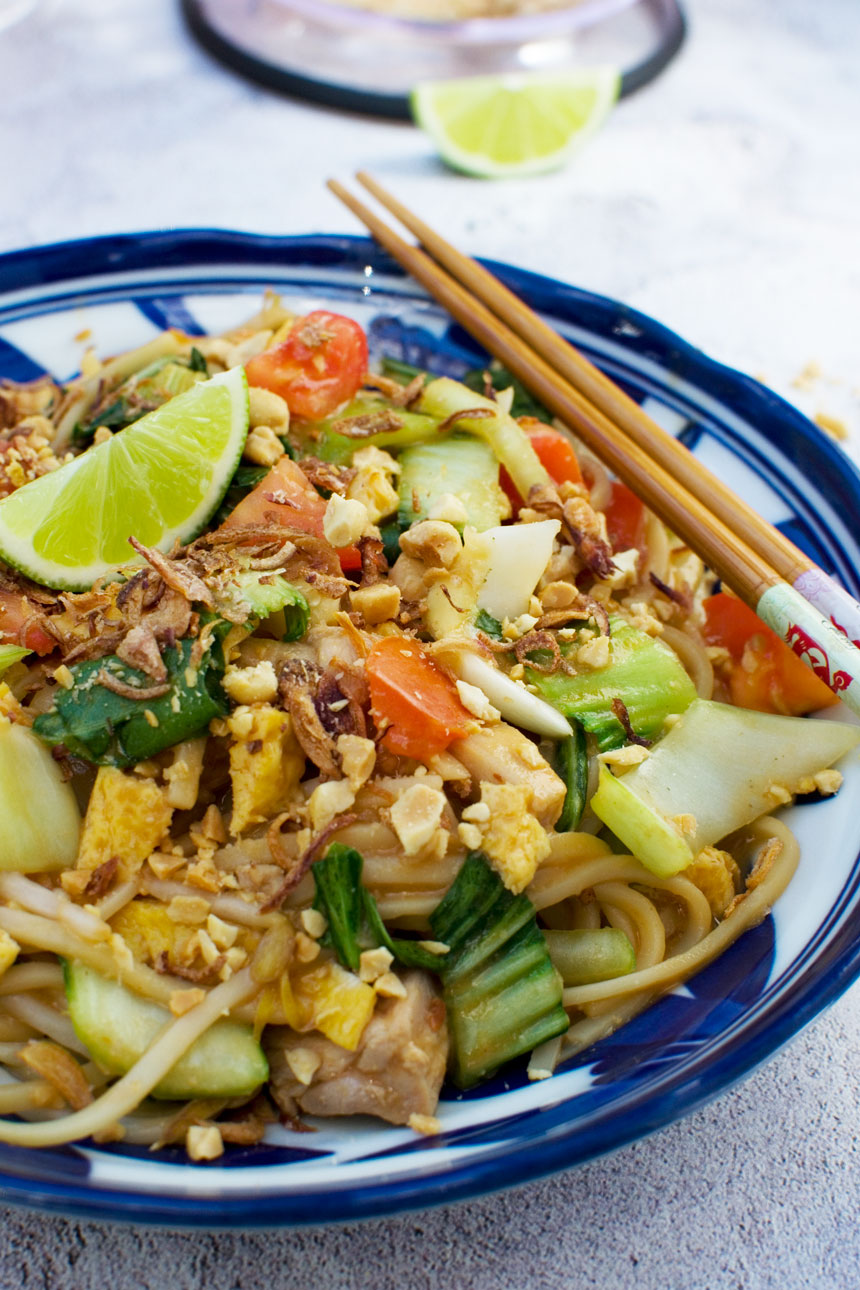
When I visited Singapore, Mr. Scrummy and I ate virtually every meal in the incredible street food markets there. One of the dishes we both enjoyed the most was mee goreng, an amazingly tasty fried egg noodles dish.
From the moment we got home, I was on a quest to make the best version of this new favourite dish I’d discovered. I hope you give it a try and enjoy it as much as we still do.
What is mee goreng?
I first discovered this dish in Indonesia, but it’s popular in Malaysia and other parts of Asia, too.
Essentially mee goreng (sometimes called mi goreng or mie goreng) is a mildy spicy chicken noodle stir fry with egg and Asian greens and beensprouts and other yummy things.
One of the things I love about it is that there is a range of textures. So in mee goreng you’ll find:
- fresh and crunchy Asian vegetables
- yummy fried egg noodles
- tasty chunks of tender chicken
- a tangy, mildly spicy sauce (plenty of it in my version!)
- a crispy, crunchy garnish of peanuts, crispy dried onions (my favourite!) and lime segments.
Just slice down the middle of Asian greens like the baby pak choi shown here length-ways, then chop like you would a leek. Then wash really well! It can be gritty!
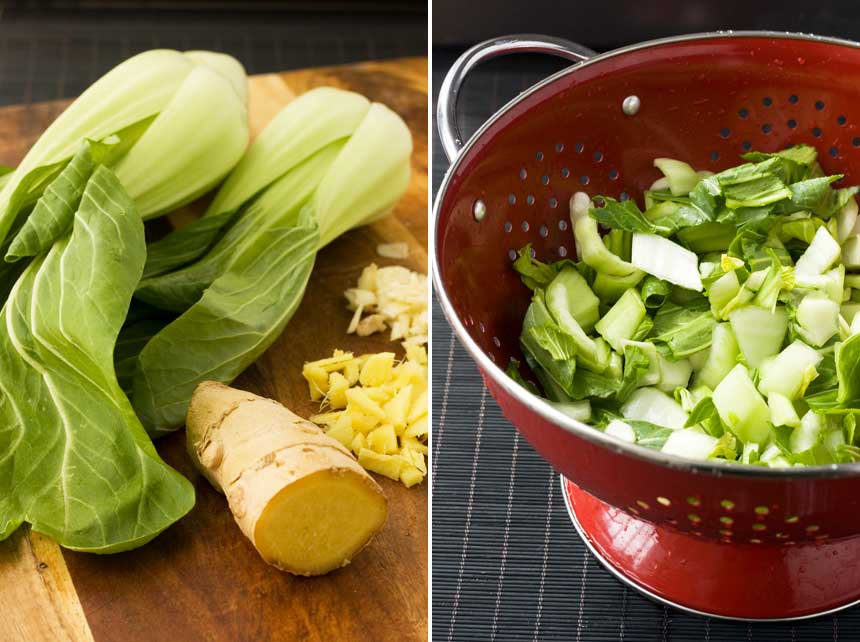
Why I think this is the best recipe
I don’t claim my mee goreng recipe to be perfectly authentic. Over time I’ve developed it to include all the best things from the different versions of the recipe I’ve seen.
This is one of those dishes that everyone has their own version of. Some recipes include eggs, for instance, so I do too. There are chopped tomatoes in my version, too, for extra juice and taste.
The dish ends up neither too spicy nor too bland. Full of ‘bits’ but with plenty of the comforting noodles, too.
But what really takes these Indonesian street noodles from good to delicious? Easy – the sauce and the toppings!
The sauce
I used to be afraid of long lists of ingredients in Asian stir fry recipes. I still am – a bit – but luckily the sauce in this recipe only contains 6 ingredients + water.
The sauce contains a sticky, sweet version of soy sauce called kecap manis. Don’t worry, it’s easy to find in major supermarkets. I also include… wait for it… tomato ketchup in my version of the sauce!
There’s also light soy sauce, a bit of chili sauce – not too much, and oyster sauce.
Lastly, I add a sneaky tablespoon of peanut butter. Just because.
You could say this version is actually a mee goreng basah, which roughly (very roughly!) translates as very saucy, I make sure there’s just the right amount of sauce!
The toppings
Oh, the toppings. They are not optional. They really aren’t 😉 They are just as important as all the other ingredients to get that perfect flavour explosion in your mouth.
This is what I recommend:
- crushed peanuts
- dried onions, which you can usually grab in the supermarket (if not, it’s well worth hunting them down in an Asian shop!)
- lime segments to squeeze all over just before eating
Oh, and I suggest adding more of the toppings as you eat. Just trust me on that!
How to make it
Like with any stir fry, I find it’s best to get all the ingredients washed, chopped and otherwise prepared before starting to cook. You can even do some of the prep ahead so that it’s a super fast meal when dinnertime comes around.
The prep will take a little while – 15 to 20 minutes. But then it’s just a case of throwing everything together in a wok or other big pan.
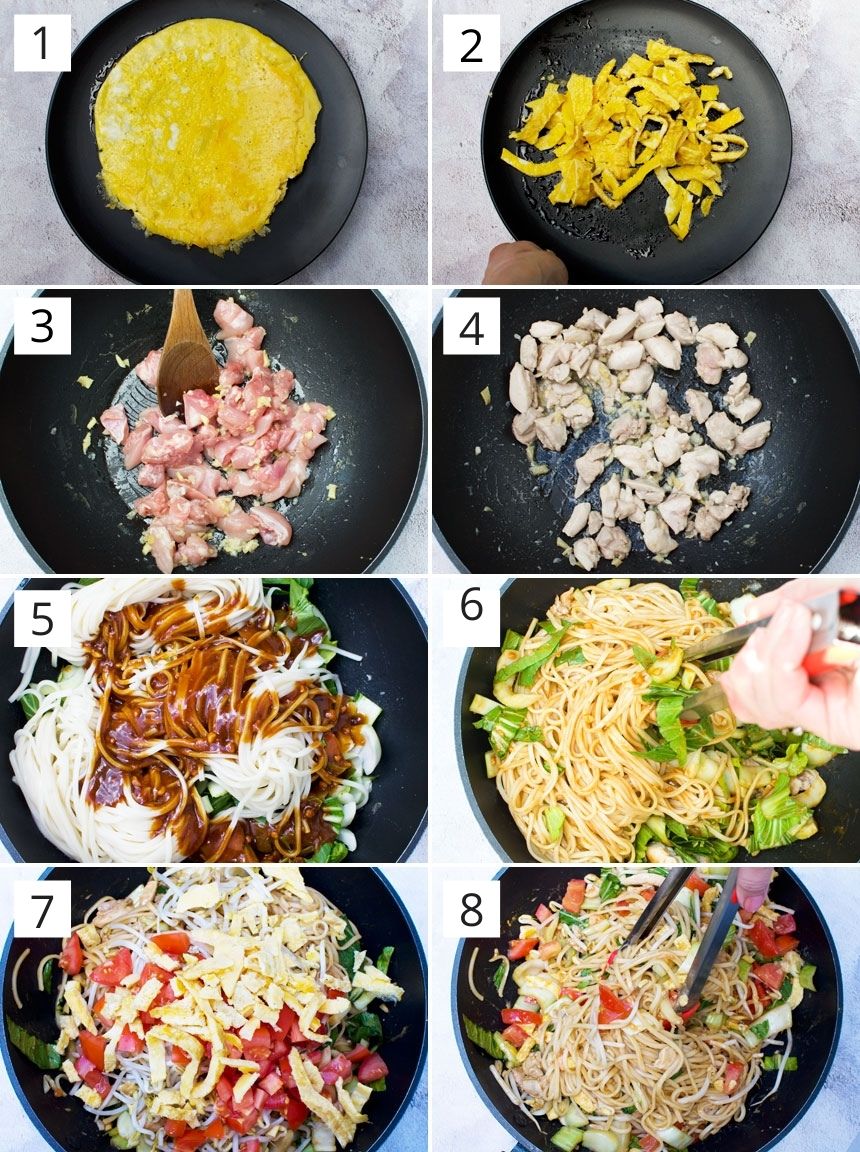
There are really only 5 main steps to the recipe:
Step 1: Cook the egg. Cook it like a big flat omelette. Then roll it up, chop it up, and put it aside. Easy.
Step 2: Cook the chicken with yummy garlic and ginger. At the same time, you can be cooking your egg noodles, which only takes a few minutes.
Step 3: Throw in the greens, noodles, and the sauce.
Step 4: Add the rest of the ingredients – so chopped tomatoes and egg, and the beansprouts. Add a drizzle more water to keep it nice and ‘saucy’.
Step 5: After serving into bowls, sprinkle with the delicious toppings. Grab your chopsticks and eat!
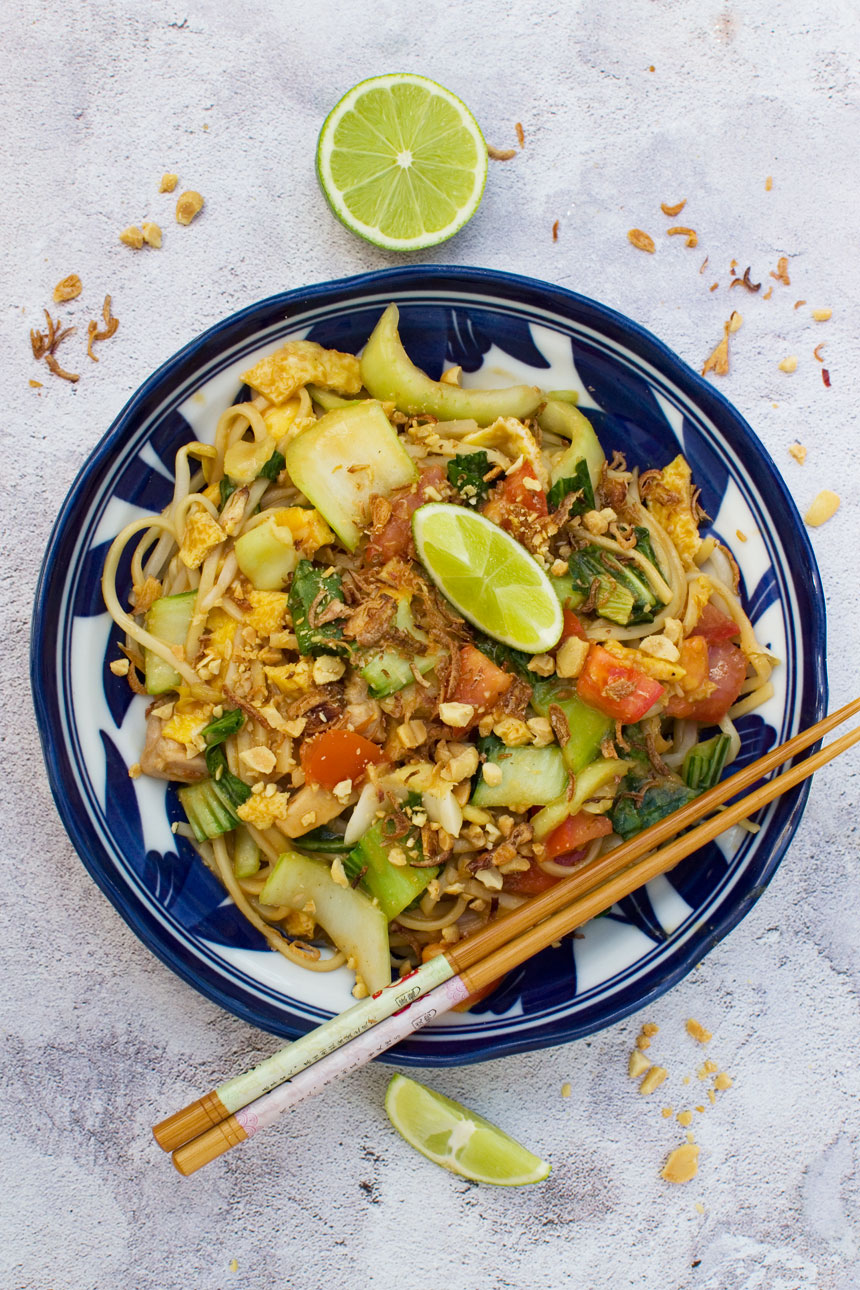
What kind of noodles to use
This dish is made with egg noodles. I usually use medium sized egg noodles – so neither super thick nor super skinny.
But really it’s up to you. You can even use a different type of noodle like wheat or rice noodles if that’s what you have.
Sometimes I buy fresh noodles, called Hokkien noodles in the supermarket I go to. Other times I buy dried egg noodles. Again, it really doesn’t matter.
The only important thing is to use less than half the weight of fresh noodles if you’re using dried. For example: Use 400 grams or 14 ounces of fresh noodles but only 170 grams or 6 ounces of dried noodles.
Make the recipe your own
I’ve already told you that I took a while to refine this recipe to make it my own.
Mine’s an egg noodle stir fry with chicken, but you could make yours a shrimp, pork or beef mee goreng. Or you could skip the meat and add tofu or more vegetables if you prefer.
My stir fry is just mildly spicy, so add more chili sauce if you like to feel the heat. If you like, you could also add an egg on top of your noodles before serving. Yum. The world’s your noodle!
More things to know (recipe FAQ)
Yes. If you prefer to use dried noodles, use just under half the amount of fresh. So you’ll need around 6 ounces or 170 grams of dried noodles for this recipe.
I usually make this dish with chicken, but there’s no reason why you can’t use pork, beef strips, shrimp/prawn, tofu or just loads of vegetables instead. The method won’t really change because the dish is cooked so quickly. Just cook any protein you like at the same time as you would cook the chicken.
I always use chili sauce in my mee goreng recipe. I use around 3 teaspoons so that the noodles are just mildly spicy. Honestly though, tweak the amount to your heart’s content! It can be as spicy (or not) as you like.
I usually grab a bottle of sriracha sauce from the Asian aisle at my local supermarket. But really any kind of chili sauce works. You can even use sambal oelek as a substitute, or you can skip the chili sauce altogether and just add more ketchup if you’re not a fan of spicy dishes at all.
Gosh yes. Like any good takeout style dish, the leftovers reheat really well. Simply cover and reheat for 3 to 4 minutes on 80% power in your microwave. Sometimes I add a little drizzle of water before reheating so that the dish is nice and ‘saucy’ again.
Alternatively you can reheat the leftovers in a wok. Just add a drizzle more water and stir fry again for a few minutes until piping hot.
Add some fresh toppings (peanuts, lime, crispy shallots, coriander) after heating for a meal that’s as good as new. Yum.
Ha! Great question! I always used to wonder that too.
Basically, ‘mee goreng’ means fried noodles in Indonesian. ‘Nasi goreng’ means fried rice. So they are similar stir-fried dishes with sweet soy sauce, vegetables and protein but one is made with noodles and the other with rice!
Here is a recipe for nasi goreng from Nagi at Recipe Tin Eats if you’d like to try that too.
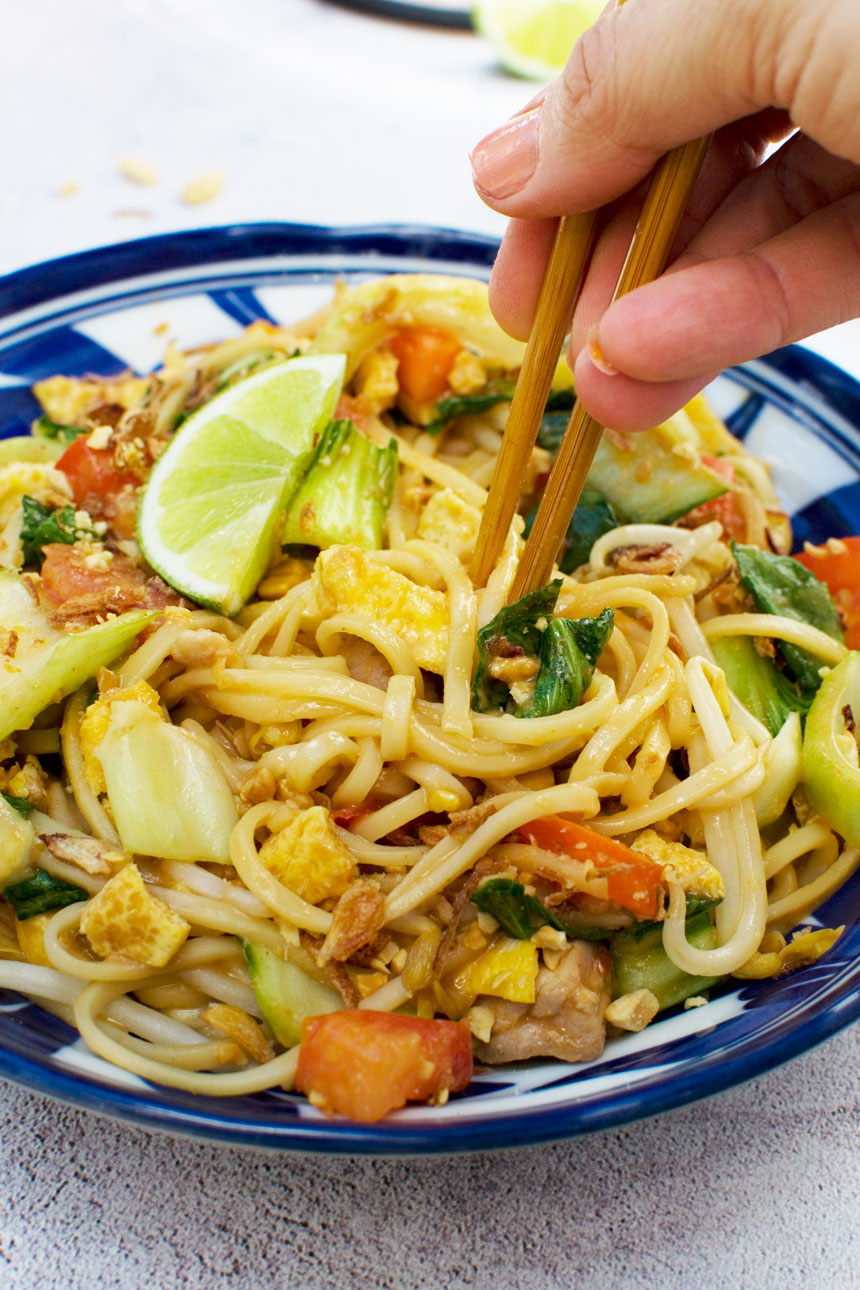
More easy Asian meals
- 15 minute Thai basil pork stir fry (delicious!)
- This 20-minute chicken and cashew nuts is another quick and easy Chinese takeout classic!
- Perfect Thai chicken and butternut squash curry (On the table in 40 minutes and makes a TON. We ALWAYS have some of this in our freezer!). More in the mood for fish? Try this 20-minute Thai green curry with fish.
- Sticky and delicious 15 minute Shanghai chicken
- This easy chicken katsu curry is one for crispy chicken lovers everywhere, and there’s even an air fryer option!
- Or take a look at all my Asian recipes.
Mee goreng makes a great simple weekend dinner! If you need more ideas, check out this list of 100 easy Sunday dinner ideas.
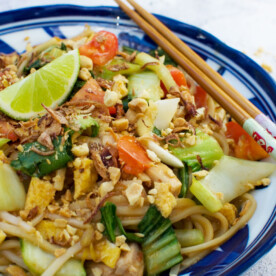
The Best Indonesian Noodles (Mee Goreng)
Equipment
Ingredients
for the sauce
- 1 tablespoon peanut butter
- 1 tablespoon kecap manis, (thick sweet soy sauce)
- 1 tablespoon light soy sauce
- 3 teaspoons chili sauce, I used sriracha, but any is fine
- 1 tablespoon tomato ketchup
- 2 tablespoons oyster sauce
- 3 tablespoons water
for the noodles
- 1 tablespoon vegetable oil, for cooking (or sesame oil)
- 2 eggs, lightly whisked
- 2 garlic cloves, chopped finely or crushed
- 3cm piece fresh ginger, (about a thumb's width) peeled and chopped finely
- 7 ounces chicken breast, or 2 chicken thighs, chopped into smallish chunks
- 9 ounces baby pak choi, chopped and washed
- 14 ounces fresh egg noodles, or 6 ounces/170 grams dried
- 3.5 ounces beansprouts, I use fresh but canned would be OK too. (3.5 ounces is 100 grams or 2 large handfuls)
- 2 medium tomatoes, roughly diced
toppings
- lime segments
- crispy fried shallots
- crushed peanuts or cashew nuts
Instructions
- In a medium bowl or jug, blend the kecap manis (thick sweet soy sauce) and light soy sauce into the peanut butter, then whisk in all the other sauce ingredients. Set aside.
- Add a drizzle of oil to a wok on a medium heat. Then pour eggs in. Roll the pan to spread it out, like you would a pancake. Cook for about a minute. Flip over for a few seconds, then transfer to a plate, roll up and cut into thin strips. Set aside on a plate.
- Add another drizzle of oil to the heated wok/pan, then add the garlic, ginger and chicken. Stir fry until just cooked through (2 to 3 minutes).
- Add the pak choi to the pan and stir fry for another couple of minutes until wilted. Then add the noodles. Pour in the sauce at this point and combine all the ingredients well.
- At the last minute, add the beansprouts, tomatoes and eggs and combine well once again. Add a little extra drizzle of water if you think the dish needs it.
- Serve the noodles immediately, topping with the lime, crispy shallots and crushed nuts. Enjoy!
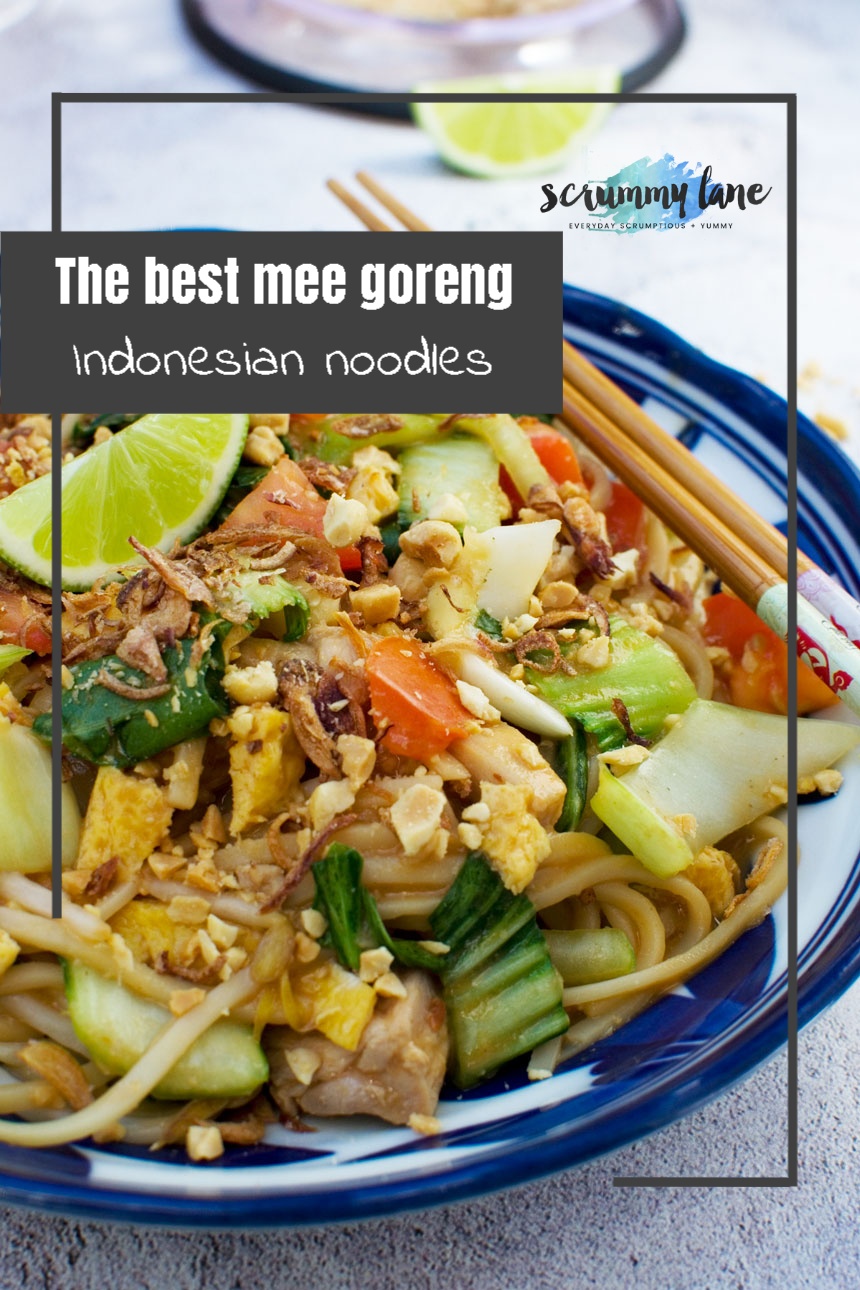
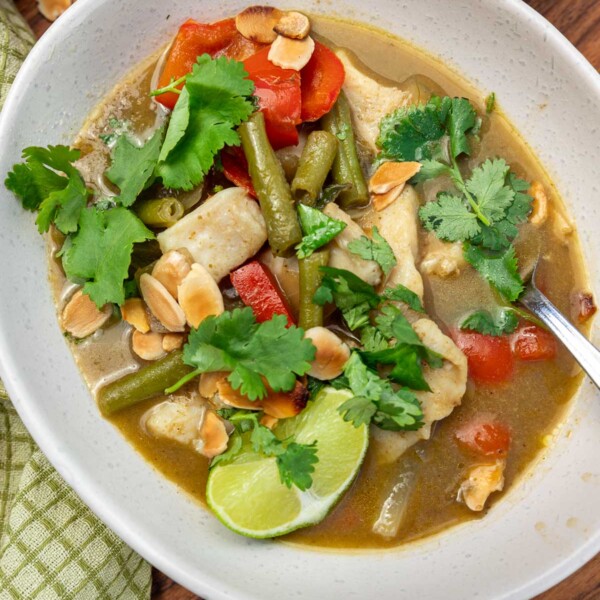
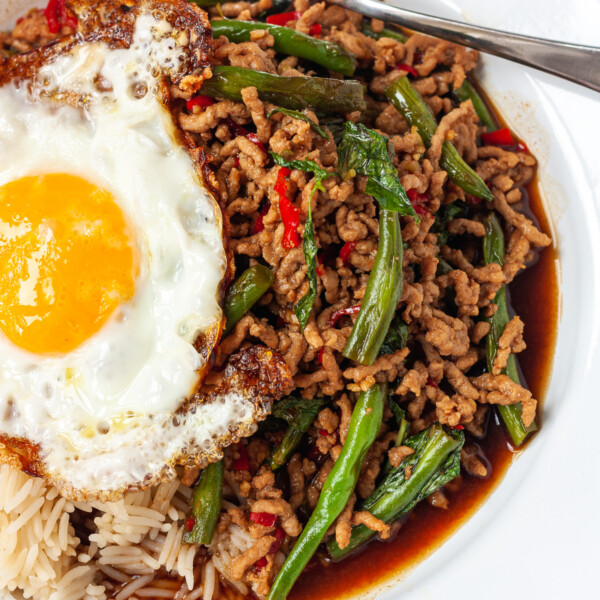
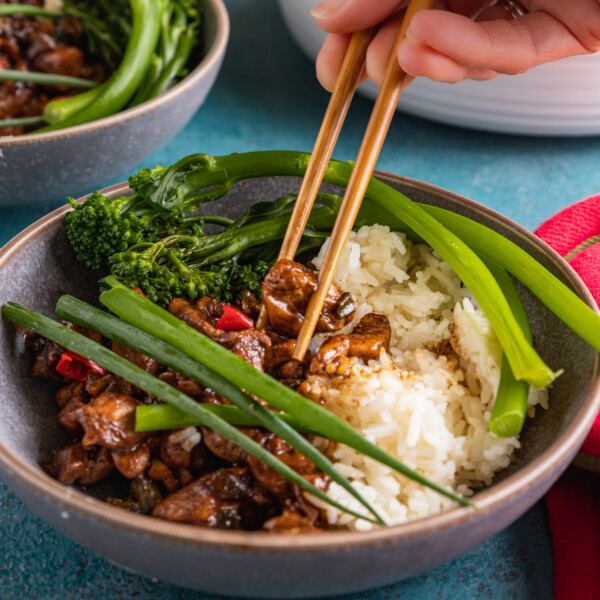
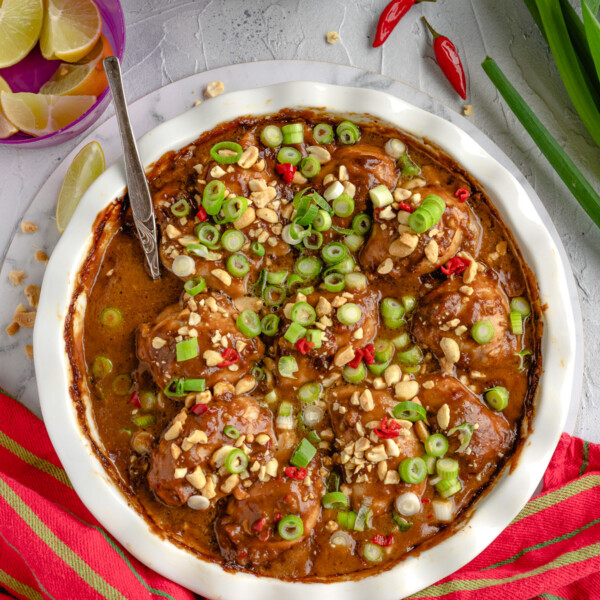






Hello, just wondering what greens you use in this recipe? I’ve jsut returned from Bali and there was this one place I bought mi goreng from every day over there. They had these chopped up stem looking green vegetables, they were hard and crunchy the flavour wasn’t really there but I loved them in the dish!! Any chance you know what these could be? And also just generally curious what greens you put in yours ☺️
Hello Georgia! I created this recipe after eating mee goreng several times on a trip to Singapore, but I wanted to add together all the things I liked best about each version and make sure they were all in there together in my version of the recipe! So I hope you like this as much as the versions you tasted in Bali! As for the greens, I usually use ‘pak choi’ or ‘bok choy’. They’re pretty similar and I can usually get one or the other in my local supermarket, but if you can’t try an Asian supermarket – you should find it there. Good luck! Let me know what you think!
I make mee goreng a lot because it’s quick and my family like it. The Indian version of mee goreng in Singapore often has the addition of slices of boiled potato which give a nice texture to the dish and if fried for long enough, break up a little and coat the noodles. I also add choi sum (from Waitrose/Sainsburys/Tesco) which is a leafy vegetable which is popular in Asia. Finally, this is often served with an accompaniment of sliced cucumber that has a dollop of tomato sauce!
Hello Lena! Thank you so much for the info! I love it! I’ve never tried a mee goreng with potato but it sounds incredible. 🙂
I made your lovely pad ga prao last week which was gorgeous and very simple. Since I had the more unusual Asian ingredients in the fridge, I made this one tonight. Again, delicious and really easy. I would honestly have paid £10 in a restaurant for it. OH very impressed too. I didn’t have sesame oil so just used a touch of vegetable oil instead. It was phenomenal. Thanks!
Hello Rachel! This sort of message really makes my day – thank you for taking the time to come here and leave your feedback!
I seem to get lots of positive feedback on this recipe, and now you’ve really made me want to make it again soon. If you like this and the pad ga prao, you might like my spicy peanut chicken too – similar Asian flavors and REALLY delicious if you’re a peanut-y sort of person! 🙂
Hi I’m Indonesian, living in Sydney currently. And been craving for Indonesian food. I came across to your website and decided to give this recipe a go.
And I’m so glad I did! It was delicious! I doubled the sauce and added a bit of nasi goreng paste, it was perfect!
Thanks again for the easy recipe!
Wow, I’m amazed (and humbled, to be honest!) that an Indonesian gave this a go and liked it! Thank you so much for popping by and giving your feedback! And of course it’s never a bad idea to double sauce!
Truly sensational!!! I’ve tried other stir fry recipes and they always turn out mushy or flavourless. This folks is restaurant quality. I can’t wait to serve this at my next dinner party
So happy you liked this so much, Sammy! This is my all-time favourite stir-fry, too. I really worked on getting maximum flavour into it without too much fuss. I’m very flattered that you thought it was restaurant quality! Thank you!
Could you tell me what other type of noodles I could use? My shopping is a bit limited. Thanks!!
Hi Judy! To be honest you could give this a go with any noodles you like! I usually use egg noodles, but I think it would still be delicious with wheat flour noodles, or you could even just use spaghetti in a pinch. If you can’t find fresh noodles, just pre-cook dried ones and add them at the end. What kind of noodles can you find? 🙂
Oh my gosh. I just tried this recipe after seeing it on Pinterest and I had to report back to you that it was a HUGE hit. It was so good! Usually I am skeptical of making Asian recipes at home because they never taste like takeout to me, but this was so much better! It’s going into regular rotation in our house. Thanks so much for sharing with us!
Hi Lara! Thank you SO much for popping by to leave such a glowing review. You’ve really made my day! Everyone I know who’s made this (and many readers) have loved it. There’s something about it, isn’t there? It’s just SO tasty. Mmmm … now you’re making me crave this again!
Have you tried my ‘mee goreng’ as well – if you like this, I think you might enjoy that too! 🙂
Had some doubts that buying all these “special” ingredients for what could possibly be a one-time dish was going to be worth it but you made it look so delicious we had to give it a try. Needless to say this is NOT a one time dish…we will be making it again and again because it is kickass!
Thanks so much for sharing.
Hello Dana! Your comment really made my day today. I’m so happy that you enjoyed this so much. I must admit it’s got more ingredients in it than I’d usually use in one recipe, but I agree with you – totally worth it. Thanks so much for popping by and letting me know that you enjoyed it – I REALLY appreciate it!
Happy Holidays! 🙂
Tried this tonight, it’s fantastic! I love the sauce 🙂 added a little extra dash of sriracha (like it spicy) and it turned out awesome. Will be making this many times in the future. Thanks for the amazing recipe!
Hello! So so happy to hear that you tried this and liked it. It’s one of my favourite recipes for sure. In fact now you’ve reminded me that I haven’t made it in a while and really must! Thank you so much for taking the time to post your feedback and … Happy holidays!
P.S. You might like my spicy peanut chicken too 🙂
Made this for dinner tonight and oh my was it good. The sauce is just amazing. I could eat it pretty much every night too.
Hello, Caroline! Oh wow, I am so pleased that you made this and enjoyed it! It really is fabulous, isn’t it? Pretty much my favourite meal, if I had to choose just one (pretty tricky!) Thank you so much for taking the time to try this and most of all for letting me know what you thought. 🙂